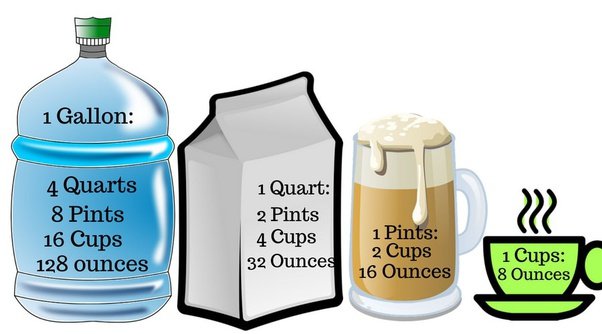How many OZ in a Gallon of water

There are 128 ounces in one gallon [US liquid gallon]. Here’s a breakdown for easy conversion:
- 1 US liquid gallon = 128 US fluid ounces
- 1 gallon (US) = 3.785 liters (for metric conversion)
It’s important to note that the volume can vary slightly depending on the type of gallon being used. Here are some common examples:
- US liquid gallon (most commonly used in the United States) – 128 fl oz
- US dry gallon – 256 fl oz (used for dry goods like grains and powders)
- Imperial gallon (used in the United Kingdom and some Commonwealth countries) – 160 fl oz
What Is An Ounce?
An ounce (oz) is a unit of weight or mass typically used in the imperial and US customary systems. It can be used for both dry and liquid ingredients, although depending on the context, the type of ounce might be implied. Here’s a breakdown of ounces and their applications:
Types of Ounces:
-
Fluid Ounce (fl oz): This type of ounce is used to measure liquids. There are two common variations:
- US fluid ounce (fl oz): The most common type in the United States, equal to 1/128 of a US liquid gallon (approximately 29.57 milliliters).
- Imperial fluid ounce (fl oz): Predominantly used in the United Kingdom and some Commonwealth countries, equal to 1/160 of an imperial gallon (approximately 28.41 milliliters).
-
Avoirdupois Ounce (oz): This type of ounce is used to measure weight, most commonly for dry ingredients or small objects.
- US avoirdupois ounce (oz): Equal to 1/16 of a US pound (approximately 28.35 grams).
Understanding Context:
In recipes or grocery store measurements, ounces are often used without specifying the type. In these cases, it’s usually safe to assume US fluid ounces for liquids and US avoirdupois ounces for dry ingredients.
However, if you’re dealing with international recipes or scientific measurements, it’s crucial to pay attention to the notation (fl oz or oz) to ensure accurate conversion.
Conversion to Other Units:
For easier comparison with metric units, here are some conversion factors:
- 1 US fluid ounce (fl oz) = 29.57 milliliters (ml)
- 1 US avoirdupois ounce (oz) = 28.35 grams (g)
Beyond the Kitchen:
Ounces are also used in other contexts beyond cooking and groceries. For example:
- Precious metals like gold and silver are often priced per troy ounce, a unit specific to the precious metals trade (slightly heavier than a standard avoirdupois ounce).
- Beverage sizes in some countries might be listed in ounces.
By understanding the different types of ounces and their applications, you can ensure accurate measurements in various situations.
What Is A Gallon?
A gallon is a unit of volume used primarily in the imperial and US customary systems for measuring liquids. It’s a relatively large unit, often used for bulk quantities like:
- Milk jugs
- Gasoline tanks
- Beverage containers (large jugs)
- Paint and other liquid supplies
There are two main types of gallons to be aware of, as they differ slightly in size:
-
US liquid gallon (most commonly used in the United States): This is the standard gallon you’ll encounter in most everyday situations. It’s equal to:
- 128 US fluid ounces (fl oz)
- 3.785 liters (metric conversion)
-
Imperial gallon (used in the United Kingdom and some Commonwealth countries): This gallon is slightly larger than the US gallon. It’s equal to:
- 160 imperial fluid ounces (fl oz)
- 4.546 liters (metric conversion)
When referring to gallons, it’s sometimes helpful to clarify the type (US gallon or imperial gallon) to avoid confusion, especially if dealing with international measurements or conversions.
Here are some additional points to consider about gallons:
-
A gallon is a unit of volume, not weight. This means a gallon of water will weigh differently than a gallon of oil, even though they occupy the same volume.
-
Gallons can be further subdivided into smaller units. For example, a US gallon can be divided into four quarts, eight pints, or 128 fluid ounces.
-
There’s also a US dry gallon. This unit is used for measuring dry goods like grains and powders, and it’s significantly larger than a US liquid gallon (256 fl oz). However, dry goods are typically measured in smaller units like cups or pounds, so encountering a dry gallon in everyday situations is less common.
That’s a perfect conversion table you’ve created! It clearly shows the equivalent measurements between fluid ounces (fl oz), cups, pints, quarts, and gallons.
Here’s a breakdown of the equivalencies you’ve listed:
- 1 gallon = 128 fl oz
- 1 quart = 32 fl oz = 4 cups
- 1 pint = 16 fl oz = 2 cups
- 1 cup = 8 fl oz
The table effectively demonstrates how the volume increases as you move down the table and the units get larger.
When it comes to measuring ounces and gallons internationally, things can get a bit tricky. Here’s a breakdown of the key points to remember:
Fluid Ounces (fl oz):
-
There are two main types of fluid ounces:
- US fluid ounce (fl oz): This is the standard fluid ounce used in the United States. It’s equal to 29.57 milliliters (ml).
- Imperial fluid ounce (fl oz): Predominantly used in the UK and some Commonwealth countries. It’s slightly larger than the US fluid ounce, equaling 28.41 milliliters (ml).
-
Pay attention to the notation (fl oz or oz) in recipes or measurements, especially when dealing with international sources.
-
For the most accurate conversions, use the specific type of fluid ounce mentioned (US fl oz or imperial fl oz).
Gallons:
-
Just like fluid ounces, there are two main types of gallons:
- US liquid gallon: The most common gallon, equal to 128 US fluid ounces (fl oz) or 3.785 liters (l).
- Imperial gallon: Used in the UK and some Commonwealth countries. It’s larger than the US gallon, equaling 160 imperial fluid ounces (fl oz) or 4.546 liters (l).
-
Specifying the type of gallon (US gallon or imperial gallon) is crucial to avoid confusion, especially in international contexts.
Wet Vs Dry Gallons
There’s a common misconception about wet vs. dry gallons. In reality, the gallon itself is a unit of volume, not weight or density. This means a gallon container will hold the same amount of liquid regardless of whether it’s water, oil, or even gasoline.
However, there are two types of gallons that differ in size:
-
US Liquid Gallon (most commonly used): This is the standard gallon you’ll encounter for liquids. It’s equal to 128 fluid ounces (fl oz) or 3.785 liters.
-
US Dry Gallon (less commonly used): This unit is specifically used for measuring dry goods like grains, powders, and feeds. It’s significantly larger than a US liquid gallon, equaling 256 fluid ounces (fl oz).
Here’s a table summarizing the key points:
| Gallon Type | Used For | Volume (fl oz) | Liters |
|---|---|---|---|
| US Liquid Gallon | Liquids | 128 | 3.785 |
| US Dry Gallon | Dry Goods | 256 | 7.571 |
The confusion around “wet” and “dry” gallons likely stems from historical practices. In the past, different containers might have been used for measuring liquids and dry goods, even if they were both called gallons. However, the actual unit of measurement (the gallon itself) remained the same.
Here are some additional points to consider:
-
Recipe ambiguity: While uncommon, some older recipes might refer to “gallons” without specifying if it’s liquid or dry. In such cases, context clues or further research might be necessary to determine the intended type.
-
International gallons: Similar to the US, some countries have separate units for liquid and dry goods, although the terminology might differ. Be mindful of these variations when dealing with international measurements.
Fluid Ounces (Fl Oz) Vs Dry Ounces
There’s a common misconception about wet vs. dry gallons. In reality, the gallon itself is a unit of volume, not weight or density. This means a gallon container will hold the same amount of liquid regardless of whether it’s water, oil, or even gasoline.
However, there are two types of gallons that differ in size:
-
US Liquid Gallon (most commonly used): This is the standard gallon you’ll encounter for liquids. It’s equal to 128 fluid ounces (fl oz) or 3.785 liters.
-
US Dry Gallon (less commonly used): This unit is specifically used for measuring dry goods like grains, powders, and feeds. It’s significantly larger than a US liquid gallon, equaling 256 fluid ounces (fl oz).
Here’s a table summarizing the key points:
| Gallon Type | Used For | Volume (fl oz) | Liters |
|---|---|---|---|
| US Liquid Gallon | Liquids | 128 | 3.785 |
| US Dry Gallon | Dry Goods | 256 | 7.571 |
The confusion around “wet” and “dry” gallons likely stems from historical practices. In the past, different containers might have been used for measuring liquids and dry goods, even if they were both called gallons. However, the actual unit of measurement (the gallon itself) remained the same.
Here are some additional points to consider:
-
Recipe ambiguity: While uncommon, some older recipes might refer to “gallons” without specifying if it’s liquid or dry. In such cases, context clues or further research might be necessary to determine the intended type.
-
International gallons: Similar to the US, some countries have separate units for liquid and dry goods, although the terminology might differ. Be mindful of these variations when dealing with international measurements.



